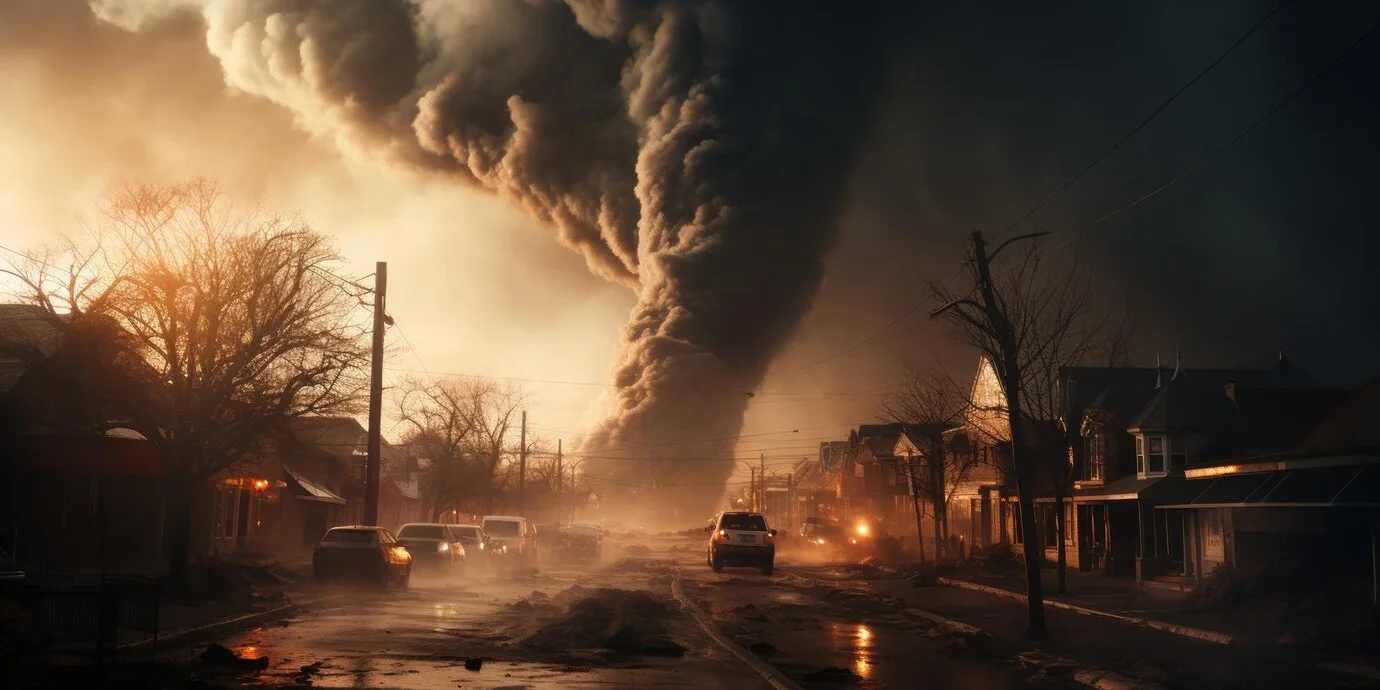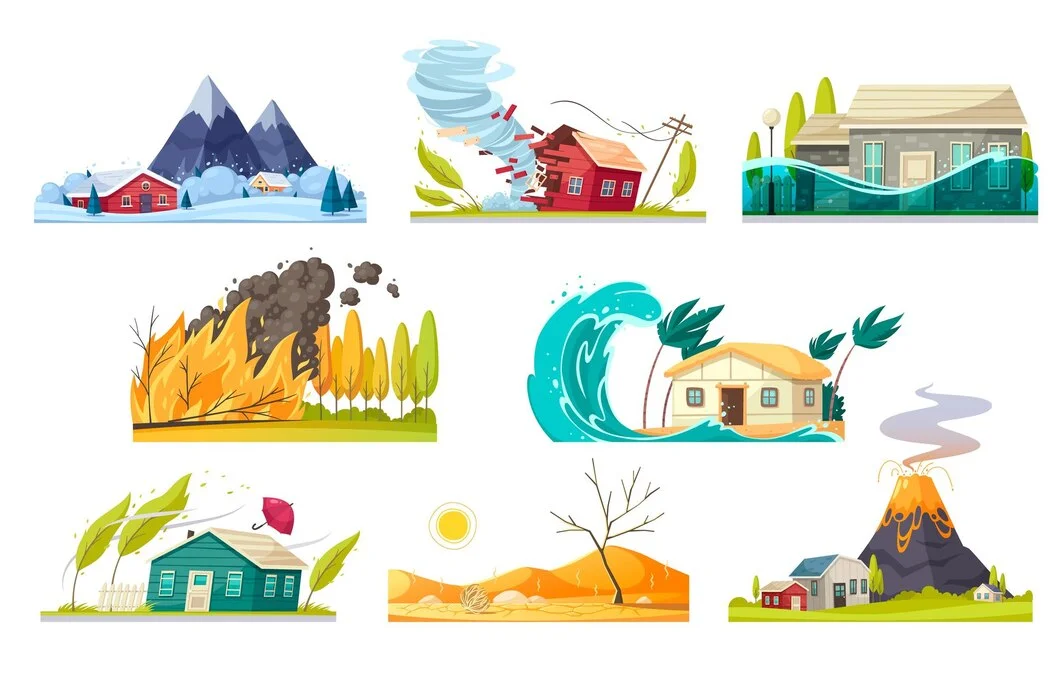Definition of Disaster Management?
A Disaster is an event or series of events, which gives rise to casualties and damage or loss of properties, infrastructure, environment, essential services, or means of livelihood on such a scale which is beyond the normal capacity of the affected community to cope with. Discover effective disaster management strategies to prepare, respond, and recover from emergencies. Learn how to protect communities and minimize impacts.
Disaster is also sometimes described as a “catastrophic situation in which the normal pattern of life or ecosystem has been disrupted and extraordinary emergency interventions are required to save and preserve lives and or the environment”.
As per the Disaster Management Act 2005, a disaster is defined as “a catastrophe, mishap, calamity or grave occurrence in any area, arising from the natural or man-made cause, or by accident or negligence which results in substantial loss of life or human suffering or damage to, and destruction of property, or damage to, or degradation of, environment, and is of such a nature or magnitude as to be beyond the coping capacity of the community of the affected area.
The United Nations defines a disaster as “the occurrence of sudden or major misfortune which disrupts the basic fabric and normal functioning of the society or community“.
Disasters are sometimes classified according to whether they are “natural” disasters or “human- made” disasters. For example, disasters caused by floods, droughts, tidal waves, and earth tremors are generally considered “natural disasters.” Disasters caused by chemical or industrial accidents, environmental pollution, transport accidents, and political unrest are classified as “human-made” or “human-induced❞ disasters since they are the direct result of human action.
A more modern and social understanding of disasters, however, views this distinction as artificial since
most disasters result from the action or inaction of people and their social and economic structures. This happens by people living in ways that degrade their environment, developing and overpopulating urban centers, or creating and perpetuating social and economic systems. Communities and
populations settled in areas susceptible to the impact of a raging river or the violent tremors of the earth are placed in situations of high vulnerability because of their socio-economic conditions. This is compounded by every aspect of nature being subject to seasonal, annual, and sudden fluctuations and
also due to the unpredictability of the timing, frequency, and magnitude of occurrence of the disasters. The International Federation of Red Cross & Red Crescent Societies defines disaster management as the organization and management of resources and responsibilities for dealing with all the humanitarian aspects of emergencies, in particular preparedness, response, and recovery in order to lessen the impact of the disaster.
List of Various Disasters
Water and Climate-Related Disasters
- Floods and drainage management
- Cyclones C. Tornadoes and hurricane
- Hailstorm
- Cloud burst
- Heatwave and cold wave
- Snow avalanches
- Droughts
- Sea erosion
- Thunder and lightening k. Tsunami
Geological related disasters
- Landslides and mudflows
- Earthquakes
- Dam failures/ Dam bursts
- d. Minor fires
Chemical, industrial, and nuclear-related disasters
- Chemical and industrial disasters
- Nuclear disasters
Accident-related disasters
- Forest fires
- Urban fires
- Mine flooding
- Oil spills
- Major building collapse
- Serial bomb blasts
- Festival-related disasters
- Electrical disasters and fires
- Air, road, and rail accidents
- Boat capsizing
- Village fire
Also Read: Side Hustle Ideas for 2024: Get Ready to Earn Extra Bucks
Biological related disasters
- Biological disasters and epidemics
- Pest attacks
- Cattle epidemics
- Food poisoning
Disaster is the product of vulnerability, hazard, and capacity.
It results from the combination of hazards, conditions of vulnerability, and insufficient capacity or measures to reduce the potential negative consequences of risk.
(VULNERABILITY+ HAZARD) / CAPACITY = DISASTER
Disaster damage occurs during and immediately after the disaster. This is usually measured in physical units (e.g., square meters of housing, kilometers of roads, etc.), and describes the total or partial destruction of physical assets.
Disaster impact is the total effect, including negative effects (e.g., economic losses) and positive effects (e.g., economic gains), of a hazardous event or a disaster. The term includes economic, human, and
environmental impacts, and may include death, injuries, disease, and other negative effects on human
physical, mental and social well-being.
Also Read: Everything You Want Is on the Other Side of Fear
Difference between Hazard and Disaster
The main difference between hazard and disaster is that hazard is a dangerous situation or event that poses a threat to humans while a disaster is an event that actually harms human’s life, property and thus disrupts social activities. Hazard is basically a situation of risk that exist in nature.
Therefore, a hazard can lead to a disaster that will completely disrupt the life conditions of the victims. However, both hazards and disasters bear potential threats to humans since both can result in loss and damage to life and property. A disaster is more critical in nature than a hazard, which might turn into a disaster in extreme circumstances.
Vulnerability
Vulnerability is the extent to which a community, structure, services, or geographic area is likely to be damaged or disrupted by the impact of a hazard.
| Types of vulnerability | Characteristics |
| Tangible/Material (easy to see, value easily determined) | Characteristics People – Lives, health, security, living conditionsProperty services, physical property loss, loss of use Economy: Loss of products and production, incomeEnvironment – Water, soil, air, vegetation, |
| Intangible/Abstract (difficult to see, value difficult to determine) | Social structures : family and community relationships Cultural practices – religious and agricultural Cohesion – disruption of normal lifeMotivation – Will to recover; government response |
| Poverty | People who are already in depressed state are less able to recover. Some people are even more vulnerable disabled. For example pregnant women, children |
| Population Growth | Population has grown dramatically over the past decade. |
| Rapid Urbanisation | Growing concentration around the capital. For example, two-thirds of the Samoan population lives in Apia. |
| Transition in cultural practices | An increase in sub-standard housing in more heavily populated urban areas changes in traditional coping mechanisms – declining self- reliance, food conservation, and preservation, warning system, etc. |
| Environmental degradation | As resources are consumed, vegetation cover is |
Natural Disasters
Natural Disasters are naturally occurring physical phenomena caused either by rapid or slow onset events that have immediate impacts on human health and secondary impacts causing further death and suffering. These disasters can be:
Geophysical (e.g., Earthquakes, Landslides, Tsunamis, and Volcanic Activity)
- Hydrological (e.g. Avalanches and Floods)
- Climatological (e.g., Extreme Temperatures, Drought, and Wildfires)
- Meteorological (e.g. Cyclones and Storms/Wave Surges)
- Biological (e.g. Disease Epidemics and Insect/Animal Plagues)
Man-Made Disasters
They are events that are caused by humans which occur in or close to human settlements often caused as a result of Environmental or Technological Emergencies. This can include:
- Environmental Degradation
- Pollution
- Accidents (e.g., Industrial, Technological and Transport usually involving the production, use or transport of hazardous materials)
Complex Emergencies
Some disasters can result from multiple hazards, or, more often, to a complex combination of both natural and man-made causes which involve a break-down of authority, looting, and attacks on strategic installations, including conflict situations and war. These can include:
- Food Insecurity
- Epidemics
- Armed Conflicts
- Displaced Populations
Pandemic
It is an epidemic of infectious disease that has spread across a large region, which can occur to the human population or animal population and may affect health and disrupt services leading to economic and social costs. It may be an unusual or unexpected increase in the number of cases of an infectious disease that already exists in a certain region or population or can also refer to the appearance of a significant number of cases of an infectious disease in a region or population that is usually free from that disease. Pandemic Emergencies may occur as a consequence of natural or man-made disasters. These have included the following epidemics: Ebola, Zika, Avian Flu, Cholera, Dengue Fever, Malaria, Yellow Fever, and Coronavirus Disease (COVID-19).
Phases of Crisis/Disaster Management:
- Pre-Crisis (Preparedness)
This is the period when the potential hazard risk and vulnerabilities can be assessed, and steps taken for preventing and mitigating the crisis and preparing for actual occurrence. These include long-term prevention measures like the construction of embankments to prevent flooding, creating or augmenting irrigation facilities and adopting of watershed management as drought-proofing measures, increasing plantations for reducing the occurrence of landslides, construction of earthquake-resistant structures, and sound environmental management.
Crisis can also be mitigated through various short-term measures, which either reduce or modify the scale and intensity of the threat or improve the durability and capacity of the elements at risk, for example, better enforcement of building codes and zoning regulations, proper maintenance of drainage systems, better awareness and public education to reduce the risks of hazards etc.
During Crisis (Emergency Response):
When a crisis actually occurs, those affected by it require a speedy response to alleviate and minimize suffering and losses. In this phase, certain ‘primary activities’ become indispensable.
These are evacuation, search and rescue, followed by the provision of basic needs such as food, clothing, shelter, medicines, and other necessities essential to bring the life of the affected community back to a degree of normalcy.
• Post-Crisis:
Recovery: This is the stage when efforts are made to achieve early recovery and reduce vulnerability and future risks. It comprises activities that encompass two overlapping phases of rehabilitation and reconstruction.
Rehabilitation: Includes provision of temporary public utilities and housing as interim measures to assist long-term recovery. Reconstruction: Includes construction of damaged infrastructure and habitats and enabling sustainable livelihoods.
Elements of Disaster Management:
These three stages – preparedness and risk management, emergency response and recovery, rehabilitation and reconstruction may be subdivided into various detailed activities as presented in Figure.
Thus, a crisis management strategy should aim at:
- Creating an appropriate legal and organizational framework.
- Making government organizations, local bodies, communities/groups and individuals at all levels aware of the risk of potential natural and man-made hazards as well as their vulnerabilities.
- Meticulous long- and short-term planning for crisis management, and effective implementation of plans and enforcement measures.
- Building resilience of the communities to face crises and ensuring their full participation.
- Building and maintaining capabilities (human and institutional), infrastructure, and logistics. • Developing and disseminating knowledge for effective crisis management. Integration of traditional knowledge in crisis management efforts.
Disaster Preparedness
Disaster preparedness refers to measures taken to prepare for and reduce the effects of disasters. That is, to predict and, where possible, prevent disasters, mitigate their impact on vulnerable populations, and respond to and effectively cope with their consequences.
Disaster Risk Reduction Framework
The disaster risk reduction framework is composed of the following fields of action:
• Policy towards Risk Management: A policy framework has to be drawn up backed by the requisite legal and institutional mechanism that focuses on risk reduction as the major priority in disaster management.
•Assessment of Risk including Hazard Analysis and Vulnerability: Risk assessment is done based on the assessment of hazards and the resilience of the community. The likely intensity, location, frequency, and past experience would determine the magnitude and impact of a likely hazard. A social, cultural, political, economic, and technological assessment of the community would indicate its vulnerability. The two combined together would give an indication of the risk.
•Risk Awareness and Preparation of Plans for Risk Mitigation: Having assessed the risk the next step is to make the stakeholders and the decision-makers aware of the risk.
• Implementation of the Plan: The disaster management plan need not be confined only to rescue and relief measures but should be all-encompassing and include measures like environment management, urban planning, and enforcement of safety laws.
• Early Warning Systems: The provision of timely and reliable information, through identified institutions, that allows the community and the government machinery to reduce their risk and be prepared to face the hazard is essential.
• Use of Knowledge: Research in the field of disaster management has contributed substantially towards acquiring knowledge about disasters and their impacts.
India’s Key Hazards, Vulnerabilities, and the Crisis Response Mechanism
Discernible changes in weather with a general increase in temperature (or a decrease in the number of cold days) have been observed in nearly all the landmasses. The Intergovernmental Panel on Climate Change (IPCC) came to the conclusion that worldwide the frequency and magnitude of all types of natural disasters are on the rise. There is also an increase in the frequency of heavy precipitation events. In some regions of the country, the frequency and intensity of droughts have increased over the past few decades.
Projections for this century show that the number of ‘hot’ and ‘very hot’ days will continue to rise. It is also likely that the intensity and frequency of extreme precipitation events will increase over many areas, resulting in a greater number of floods and landslides.
India is one of the ten worst disaster-prone countries in the world. Disasters occur in India with grim regularity causing enormous loss of life and property. According to UN Office for Disaster Risk Reduction (UNISDR) report 2017, India has been ranked as the world’s most disaster-prone country for the displacement of residents.
India is vulnerable to a large number of natural, as well as, human-made disasters on account of its unique geo-climatic and socio-economic conditions. Out of the 36 states and union territories in the country, 28 of them are disaster-prone. Almost 85% of the country is vulnerable to single or multiple disasters and about 57% of its area lies in high seismic zones. Approximately 40 million hectares of the country’s land area is prone to flood, about 8% of the total landmass is vulnerable to cyclone and 68% of the area is susceptible to drought.
The five distinct regions of the country i.e. Himalayan region, the alluvial plains, the hilly part of the peninsula, and the coastal zone have their own specific problems. While on one hand, the Himalayan region is prone to disasters like earthquakes and landslides, the plain is affected by floods almost every year. The desert part of the country is affected by droughts and famine while the coastal zone is susceptible to cyclones and storms.
Besides the natural factors, various human-induced activities like increasing demographic pressure, deteriorating environmental conditions, deforestation, unscientific development, faulty agricultural practices and grazing, unplanned urbanization, construction of large dams on river channels, etc. are also responsible for accelerated impact and increase in the frequency of disasters in the country.
The Building Materials and Technology Promotion Council (BMPTC) has recently released the third edition of the Vulnerability Atlas of India in 2019. It contains maps and tables for each State and Union Territory of India for the following hazards: Earthquakes, Wind, Floods, landslides, cyclones, and frequency of thunderstorms. It also contains housing stock vulnerability indicating the risk for each type of house.
Interested in contributing? Write for us and become part of our growing community!



